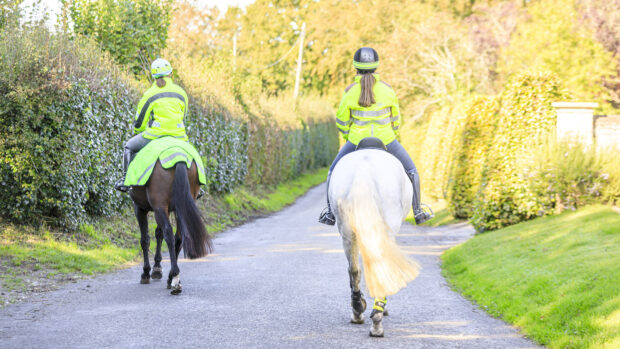THE UK’s biggest ever survey on equestrian road safety highlighted “shocking” statistics about riders’ experiences – but should help push our cause with policymakers.
The British Horse Society spoke to more than 7,000 people who access roads with horses; riding, driving and leading, and aged between 18 and 97.
Only 3% of respondents said they never felt stressed or anxious on the roads, and 43% said they did so more than half the time. The main contributor to this stress was the behaviour of other road users, cited by 93% of respondents.
Dee Pollard conducted the survey, which was funded by a grant from the Department for Transport (DfT). She told H&H she had wanted to take on such research for some time as there are very few published papers in this area.
“There was no real feel for how often equestrians are using the roads, how they’re using them and what stops them from doing so,” she said. “There’s data for walkers and cyclists but nothing really for riders. I think the DfT’s main objective was looking at reporting incidents and how to improve that but before we got there, we needed to establish a baseline, and get the full picture. It shows what an important topic this is, by the great response to it.”
A major finding of the study, which involved surveys and focus groups, was the small proportion of incidents reported, to police or the BHS; 78% said they had experienced an incident on roads that they had not reported, only 31% had reported to the police and/or BHS.
“Without an official record of incidents, when the BHS lobbies councils, highways authorities or Government, for change to make riders safer, they’ll say it isn’t a big problem because they don’t have evidence of high levels of incidents,” Dr Pollard said. “Report everything, as it strengthens our case for making roads more inclusive for equestrians.”
Dr Pollard said one possible cause for under-reporting, which came from the focus groups, is that inappropriate driving past horses has become the norm for many riders. She added that there was a desire from riders to take as much responsibility as possible for their own safety, but that “a lot relies on others doing the right thing too”.
“Sometimes they felt they had to do their own risk assessments, then do them for drivers and cyclists too, they almost took on their burden of responsibility,” she said.
Only 22% of respondents said they wear cameras, which can help secure police action, but Dr Pollard said all incidents should still be reported, with or without evidence.
Riders were also asked how they rated the risk of going on the roads compared to other equestrian activities. This was ranked as more dangerous than all other activities including going across country.
“It shows what a major concern this is,” Dr Pollard said.
BHS director of safety Alan Hiscox told H&H the study highlights “things I think everyone [equestrian] knows but now we’ve got the academic research we can use as evidence”.
He said there were positives from the responses, such as the fact 98% said they used safety equipment including high-vis gear on the roads, but other numbers such as the fact 78% had experienced incidents were “shocking”.
Mr Hiscox added that the number of incidents reported has increased by about 200% since the launch of the BHS “Horse i” app, which has had about 10,000 downloads so far.
“Interestingly, some of those are drivers who are reporting incidents to us,” he said. “There are riders unfortunately who don’t take their responsibility seriously, so we’ve got a two-way process. It’s a small minority, I’m sure, but we have to get that message out, that responsibility is a two-way thing.
“But I still think there’s lots more going on, and to get a true picture of what riders are experiencing, they need to let us know what’s happening.
He said the Dead Slow campaign will continue full steam, adding: “It’s imperative we’ve now got this data as we’ve now got figures we can hang the campaign on. It’s not just anecdotal evidence, it’s what’s actually happening.”
Dr Pollard added that in future, she would like to look into the rate of incidents for riders compared to the time they spend on the roads.
“I hope getting this done, and publishing it in peer-reviewed journals, will give Alan more evidence for when he speaks to stakeholders,” she said. “He has this in his bag, as real evidence of how equestrians feel.”
Transport minister Baroness Vere told H&H: “We’re proud of this piece of work, which will improve the safety of horse riders and help us get more people to report incidents on the road.”
You might also be interested in:

‘A significant result for riders’: proposed Highway Code changes include strong guidance on passing horses

‘We need change’: shocking statistics from major horse road safety study

Drivers educated by police in attempt to reduce horse-related road deaths

5 reasons why a subscription to HorseandHound.co.uk makes the perfect last-minute gift
Horse & Hound magazine, out every Thursday, is packed with all the latest news and reports, as well as interviews, specials, nostalgia, vet and training advice. Find how you can enjoy the magazine delivered to your door every week, plus options to upgrade your subscription to access our online service that brings you breaking news and reports as well as other benefits.




